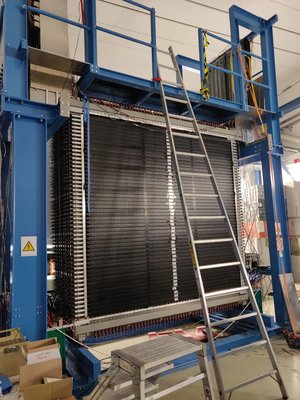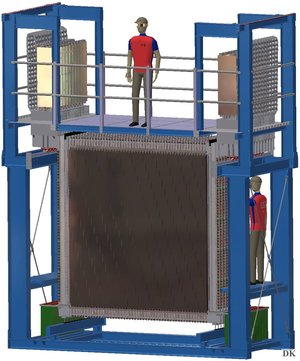Neutron ToF Spectrometer NeuLAND
Responsible: GSI.
Work is performed within the NeuLAND Working Group.
Contact person: Igor Gasparic (RBI Zagreb), Konstanze Boretzky (GSI), Andreas Heinz (Chalmers Gothenburg).
General Information
NeuLAND (new Large-Area Neutron Detector) is the next-generation neutron detector designed for R3B which meets all requirements defined by the ambitious physics program proposed for the R3B facility. NeuLAND features a high detection efficiency, a high resolution, and a large multi-neutron-hit resolving power. This is achieved by a highly granular design of plastic scintillators, avoiding insensitive converter material. The detector will consist of 3000 individual submodules with a size of 5x5x250 cm3, arranged in 30 double planes with 100 submodules providing an active face size of 250x250 cm2 and a total depth of 3 m. NeuLAND can be divided into two detectors for special applications and can be placed at different distances from the target, in order to meet specific experimental demands.
A momentum resolution of Δp/p of 10-3 similar to that for the charged particles is desired, resulting in resolution requirements for the time of flight of σ(t) < 150 ps and a position resolution of σ(x,y,z) ≈ 1.5 cm for given flight paths in the range from 10 to 35 m. For an experiment on a medium mass nucleus at about 600 MeV/nucleon, invariant-mass resolutions of about ΔE =20 keV at 100 keV above the neutron threshold will be reached using the maximum flight path. Apart from the excellent energy resolution of NeuLAND, the enhanced multi-neutron recognition capability with efficiencies of 50 to 70% (depending on the physics scenario and settings) for the 4-neutron multiplicity will constitute a major step in neutron detection.
The table below shows the neutron separation matrices for multiplicities of 1 to 4 neutrons. Columns display the neutron multiplicity simulated at the target position, rows the neutron multiplicity derived from the calorimetric algorithm. Values are given in percent. Neutrons were simulated with 200 (left), 600 (center) and 1000 MeV (right matrix). NeuLAND with 30 doubleplanes was located at a distance of 15 m to the target. Neutrons were generated with a relative energy of 500 keV with respect to a medium heavy projectile fragment. The distance between target and NeuLAND was filled with air and a 4mm steel window. Simulations have been performed with Geant4 using the QGSP_INCLXX_HP physics list. Note, that the details of the separation matrices strongly depend on the possible maximum neutron multiplicities and of the detailed settings. In the case simulated here, we assume an experiment with a maximum multiplicity of four neutrons impinging on the detector. As a consequence the probability to find a 4-neutron event in the correctly reconstructed neutron multiplicity is larger than for 2 or 3 neutrons.
The final design, containing details of the technical realization of NeuLAND, including mechanics, readout electronics, submodules tests, calibrations, and the construction procedure are described in the NeuLAND Technical Report , summarizing the result of several years of R&D efforts. Different design concepts have been investigated, including converter-based solutions, e.g., a detector based on steel converter plus charged-particle detection with resistive-plate chambers (RPC). The RPC concept has been ruled out mainly because of its insufficient multi-neutron detection capability. A fully active detector with calorimetric properties has turned out to be the best solution. The NeuLAND Technical Design Report has been finalized in 2011 and accepted by FAIR on January 18, 2013.
In 2012, the prototype of the NeuLAND detector consisting of 150 bars has been tested at GSI resulting in time resolutions better than the required σ(t) ≤ 150 ps, even with inexpensive photomultipliers. In accordance with simulations, improved timing properties have been obtained with optimized light guides.
The construction of the detector has started in spring 2013. During Oct. 2014 the NeuLAND demonstrator ( 1/6 of the full size detector) was successfully tested in GSI beam times. The mounting of NeuLAND double-planes is carried out at GSI with a team from contributing institutes guided by the R3B local group. Necessary quality controls have been established. Prior to the installation of NeuLAND at its final location in the R3B hall at the FAIR site, the part of the detector which is presently available, has been commissioned and is used in ongoing experiments at Cave C.
More details can be found in the dedicated paper:
"NeuLAND: The high-resolution neutron time-of-flight spectrometer for R3B at FAIR", K. Boretzky et al,
Nuclear instruments & methods in physics research / A 1014, 165701 (2021) [10.1016/j.nima.2021.165701]
NeuLAND Status
August 2023
The "excursion" of the NeuLAND demonstrator to RIKEN from 2015-2017 pays off:
The use of the demonstrator was essential for the detection of multiple neutrons stemming in the SAMURAI experiment on the decay of 28O. Its results were published in Nature (Kondo, Y., Achouri, N.L., Falou, H.A. et al. First observation of 28O. Nature 620, 965970 (2023). https://doi.org/10.1038/s41586-023-06352-6)).
See also https://www.gsi.de/en/start/news/details/2023/10/05/28-o-measurement
March 2022
A thirteenth double plane has been inserted into the NeuLAND structure. The Phase-0 experiments S522 on short-range correlations in exotic nuclei and S509 on multi-neutron correlations in drip-line nuclei were performed using NeuLAND. For the latter NeuLAND with its high granularity is the key detector to allow for the detection of multiple neutrons.
October 2021
NeuLAND comprising 12 double planes, thus 40% of final detector depth, was used in the Phase-0 experiments S455 studying nuclear fission and S515 investigating EOS parameters from the measurements of accurate cross sections in the Tin isotopic chain.
November 2020
NeuLAND is located at the zero-degree line at the rear part of Cave C as preparation for the Phase-0 beam time block in 2021/2022. For this experimental campaign, 12 double planes, which is 40% of the final detector size, are going to be used. Commissioning using cosmic rays was successfully performed for all detector channels using the final read-out electronics.
March 2020
Eight double-planes of the NeuLAND detector have bee used in the S444 "R3B commissioning" experiment and S467 "Single-particle structure of neutron-rich Ca isotopes: shel evolution alog Z=20" experiment.
March 2019
Eight double-planes of the NeuLAND detector have bee used in the S444 "R3B commissioning" experiment and S473 "Constraining energy-density functionals and the density-dependence of the symmetry energy by measurements of accurate cross sections with large acceptance at R3B" experiment. Neutrons produced in reaction between 12C and 120Sn beams with several different targets have been measured with NeuLAND.
November 2018
Eight double-planes of the NeuLAND detector have bee tested during the engineering run together with several other R3B detectors.
Details on the NeuLAND status before 2018 can be found in the archive. There, one can also find information on experiments performed at RIKEN in the period 20015-2017 were four double-planes of NeuLAND have been used as a part of the experimental setup.
NeuLAND Literature
- "NeuLAND: The high-resolution neutron time-of-flight spectrometer for R3B at FAIR", K. Boretzky et al, Nuclear instruments & methods in physics research / A 1014, 165701 (2021), [10.1016/j.nima.2021.165701]
- The NeuLAND Technical Design Report, available here.
- "NeuLAND - from the demonstrator to the start version", K. Boretzky et al, Scientific Report 2016 GSI Report 2017-1, 207-210 p. (2017) [10.15120/GR-2017-1 RESEARCH-NUSTAR-KR-1]
- "NeuLAND - from double-planes to the demonstrator", K. Boretzky et al, Scientific Report 2014 GSI Report 2015-1, 200-202 p. (2015) [10.15120/GR-2015-1-MU-NUSTAR-NR-12]
- "NeuLAND test-beam data analysis with R3BRoot framework", D. Kresan et al, Scientific Report 2014 GSI Report 2015-1, 378-379 p. (2015) [10.15120/GR-2015-1-INFRASTRUCTURE-IT-10]
- "A compact readout system for the R3B High-Resolution Neutron Time-of-Flight Spectrometer (NeuLAND)", C. Ugur et al, Scientific Report 2014 GSI Report 2015-1, 204-205 p. (2015) [10.15120/GR-2015-1-MU-NUSTAR-NR-14]
- "Multi-Neutron detection in R3B at FAIR with alternative detector model", V. Wagner et al, Scientific Report 2014 GSI Report 2015-1, 203 p. (2015) [10.15120/GR-2015-1-MU-NUSTAR-NR-13]
- "NeuLAND - from prototypes to double-planes", K. Boretzky et al, Scientific Report 2013 GSI Report 2014-1, 346-350 p. (2014) [10.15120/GR-2014-1-FG-S-FRS-11]
- "Tests of timing silicon photomultipliers for NeuLAND", S. Gohl et al, Scientific Report 2013 GSI Report 2014-1, 150 p. (2014) [10.15120/GR-2014-1-NUSTAR-KR-11]
- "Construction and Test of a Large NeuLAND Prototype Array", K. Boretzky et al, GSI Scientific Report 2012, PHN-ENNA-EXP-60
- "Recent Developments in NeuLAND Simulations", D. Kresan et al, GSI Scientific Report 2012, PHN-ENNA-EXP-64
- "NeuLAND@R3B: A Fully-Active Detector for Time-of-Flight and Calorimetry of Fast Neutrons", K. Boretzky et al, GSI Sci. Rep. 2011, PHN-NUSTAR-NR-02, p. 174.
- "Recent Developments in NEULAND Simulations", D. Kresan et al, GSI Sci. Rep. 2011, PHN-NUSTAR-NR-03, p. 175.
- "Implementation and Performance of Neutron Tracking Algorithm for NEULAND", D. Kresan et al, GSI Sci. Rep. 2011, PHN-IS-IT-13, GSI Sci. Rep. 2011, p. 272.
- "NeuLAND - Concepts for the Detection of Fast Neutrons", T. Aumann et al, GSI Sci. Rep. 2010, PHN-NUSTAR-NR-18, p. 180.
- "NeuLAND: Simulations for the Scintillator Concept ", M. Heil et al, GSI Sci. Rep. 2010, PHN-NUSTAR-NR-19, p. 181.






